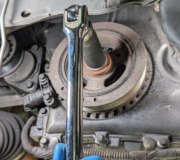Fords HAVE had a lot of engine problems from leaking head gaskets but that allows coolant into one cylinder which causes hydro-lock. I'm not aware of any extended warranties or recalls pertaining to that. It's considered a "normal" maintenance issue. What usually happens is the engine runs fine until you stop for lunch, then the cylinder fills with coolant from the pressurized system and that piston can't move. The engine won't crank an hour later. They also have a real common problem with spitting out a spark plug and peeling the threads out of the cylinder head. There are a number of repair kits for that now. I can't remember which engines that applies to.
An injector that leaks slowly is common on any brand and model of engine and typically doesn't cause a serious problem. The loss of stored fuel pressure results in a long crank time, on the order of three to five seconds, before pressure builds up enough for the engine to start. I've had that with my '88 Grand Caravan for the last 15 years. The engine is still running fine after 380,000 miles and only one timing belt and water pump repair. It takes so little fuel to leak from an injector to bleed the pressure down that it doesn't cause a problem. That raw fuel will puddle in the intake manifold and either evaporate or get burned when you start the engine.
I suspect what the mechanic might be referring to is an injector sticking open while the engine is running. That will allow a constant stream of fuel into that cylinder. If it floods it and shorts that spark plug, some of the raw fuel will just go out the tail pipe but a lot of it will wash down the cylinder walls. That will wash off the film of oil leading to rapid cylinder wall wear and worn piston rings. That lack of oil film will cause reduced power, and eventually it will dilute the oil and cause similar wear on all of the cylinder walls but that will take a while.
To add to the misery, when one cylinder misfires for any reason, there is unburned gas and oxygen going into the exhaust. The oxygen sensor on that side of the engine detects that unburned oxygen, (they don't detect unburned fuel), and reports to the Engine Computer that side of the engine is running too lean. Since the computer doesn't know which cylinder is causing that, it assumes all four are running too lean and it commands those four injectors to stay open a little longer during each pulse. It's trying to get the mixture back to correct, but no matter how much fuel it adds, there is still that unburned oxygen showing up from the misfiring cylinder. A scanner will show the exhaust is too lean but you'll likely smell the unburned fuel at the tail pipe. THAT extra fuel aggravates the problem already caused by the raw fuel washing down the misfiring cylinder wall.
What you might consider is getting the district representative involved through the dealer. When I worked for a very nice family-owned Chrysler dealership, I saw that there are very strict guidelines they have to follow. Chrysler gave them an allotment of "out-of-warranty" dollars to handle things like this, but since those funds were limited, the dealer typically reserved that for regular customers or for vehicles just slightly out of warranty. Since everything is done with computers that aren't programmed for leeway or common sense, a warranty claim will be rejected if the truck is one mile or one day beyond that warranty. THAT'S where the district representative comes in. He has the authority to warranty anything. In my case, he offered to warranty the battery in my '93 Dynasty even though I told him it was sulfated from sitting undriven for 7 years.
All Ford trucks and most of their front-wheel-drive cars have odd suspension systems that cause horrendous tire wear. That's considered "normal" wear so you won't get any warranty help with that. Also, by 2005, even earlier, the problem had been going on for so long, and everyone new about it that they finally started redesigning their suspension systems more like most other trucks.
Toyota, Hyundai, and to some extent, Chrysler, are very customer-friendly when it comes to helping their owners with these kinds of problems. Volkswagen and BMW are at the other end of the spectrum with Ford and other imports somewhere in the middle. Only General Motors is so far below the bottom of that spectrum that they need a category all their own.
If you go the dealership route, please remember they didn't design the truck, build it, or break it and they don't have any obligation to help you other than to build good will. I'm sure they will be understanding that you get moved around the country and might never come back as a customer, but they also know word-of-mouth advertising is much more valuable than any tv or radio advertising. There is no benefit in ignoring your problem so they might even recommend setting up an appointment with the district rep. They typically visit each dealership once a month. I've seen a few obviously upset people spout off to the salesmen who are in no position to solve the problem. All that gets them is a manager who wants them out of the building and who will be reluctant to work with them. People who have things documented like you do, and view the dealer as a partner in solving the problem rather than an adversary, will get the most help.
And thank you for your service. Many dealers in my area try to do a little extra for our vets.
SPONSORED LINKS
Sunday, December 4th, 2011 AT 3:19 AM




